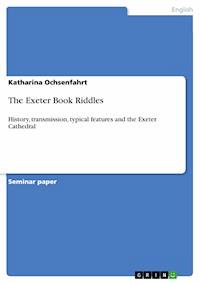
5,99 €
Mehr erfahren.
- Herausgeber: GRIN Verlag
- Sprache: Englisch
Seminar paper from the year 2012 in the subject English Language and Literature Studies - Literature, grade: 1,3, http://www.uni-jena.de/ (Anglistische Literaturwissenschaft), course: Riddles, Proverbs, Nursery Rhymes, language: English, abstract: The Penguin Dictionary of Literary Terms and Literary Theory defines riddles as an ancient and universal form of literature commonly consisting of a puzzle question. There are collections of riddles in Sanskrit, Hebrew, Arabic, Persian, Greek and Latin literature. Well-known is the sphinx as riddling beast in Grecian mythology and literature. Western riddles collections begin with the Latin collections by Symphosius in the late antiquity followed by Aldhelm’s and Tatwine’s collections. The earliest known English riddles are recorded in the Exeter Book. They originate from the 10th century. These riddles have a very special character. Craig Williamson describes them as “a metaphoric and metamorphic celebration of the life in the eye of the Anglo-Saxon.” The Exeter Riddles will be topic to this paper. First their history and transmission will the thematised by having a closer look at the Exeter Cathedral, its library and the Exeter Book. Then typical features of the riddles shall be discussed. Afterwards an example will illustrate these. Outline: 1.Introduction 2.The Exeter Cathedral 3.The Exeter Book 4.The Exeter Book Riddles 5.Riddle Nr.33 6.Sources
Das E-Book können Sie in Legimi-Apps oder einer beliebigen App lesen, die das folgende Format unterstützen:
Veröffentlichungsjahr: 2012
Ähnliche
Friedrich-Schiller-Universität Jena
Institut für Anglistik/Amerikanistik
Seminar: Riddles, Proverbs, Nursery Rhymes and other Marginal Text-types in Literature
SS 2012
The Exeter Book Riddles
by Katharina Ochsenfahrt
1. Introduction
The Penguin Dictionary of Literary Terms and Literary Theory defines riddles as an ancient and universal form of literature commonly consisting of a puzzle question.[1] There are collections of riddles in Sanskrit, Hebrew, Arabic, Persian, Greek and Latin literature.[2] Well-known is the sphinx as riddling beast in Grecian mythology and literature. Western riddles collections begin with the Latin collections by Symphosius in the late antiquity followed by Aldhelm’s and Tatwine’s collections.[3] The earliest known English riddles are recorded in the Exeter Book. They originate from the 10th century. These riddles have a very special character. Craig Williamson describes them as “a metaphoric and metamorphic celebration of the life in the eye of the Anglo-Saxon.”[4]
The Exeter Riddles will be topic to this paper. First their history and transmission will the thematised by having a closer look at the Exeter Cathedral, its library and the Exeter Book. Then typical features of the riddles shall be discussed. Afterwards an example will illustrate these.
2. The Exeter Cathedral
Exeter Cathedral is one of the great cathedrals of England.[5] It is the seat of the Bishop of Exeter, in the city of Exeter, Devon in South West England. It was founded in 1050 AD by Bishop Leofric in the large Saxon minster church that stood a few yards from the present building. The construction of the Romanesque started in 1114 AD. It was completed around 1180AD. In the following centuries the Cathedral was constantly enlarge. Fires and wars destroyed party of the building but everything was rebuilt. Today the Exeter cathedral is a magnet for visitors from all over the world. It belongs to the most impressive buildings in Britain. It has the largest ripped vaulting in the world.
The Cathedral library and archives contain irreplaceable treasures of national and international significance from the 10th century onwards, including the 10th century Exeter Book of Anglo Saxon poetry, the Exon Domesday, and the Cathedral's Charter signed by Edward the Confessor.[6]





























